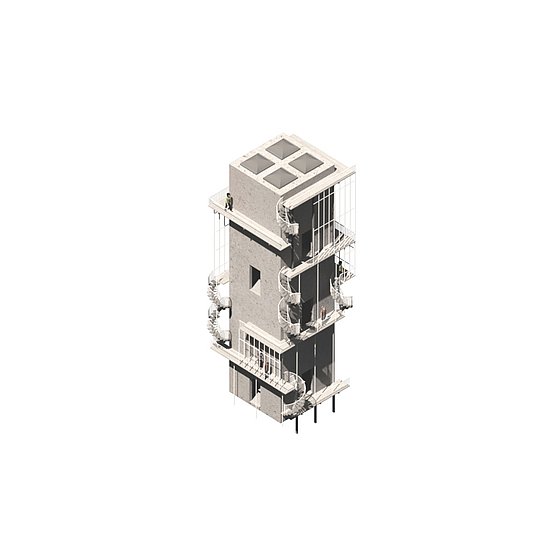The 10th International Conference on Architecture and Built Environment with Architecture AWARDs

Venue: Technical University of Darmstadt, Deutschland, 2022.
Title: The modeling grammar of the real
Author: Wonseok Chae
Abstract
This article examines the irreconcilable concept of the real between the literal and virtual realities in reference to a weird relationship between the city hall and its mockup model of Marl, Germany. After testing its real quality as a preparatory physical model, the mockup model is imposing its real value more than before by remodeling into a children's library. These days, the city hall is also going through a remodeling procedure as if resonating with the mockup model’s remodeling after about 40 years’ silence. Finally, both city hall and mockup buildings become less dependent on their original model designed by architects Van den Broek en Bakema in the 1960s. All three models seem to express their exclusive quality of the real in mutually exclusive realities yet, bound each other with the same modeling grammar. The speculation to the real seems to be inevitable as the idea of real becomes questionable. Little attention has been drawn to the extent to why the concept of the real represents al-mighty yet, only within exclusive realities based on the Post-war architectural discourse. Through the critical assessment of the mockup model and the city hall building, this article attempts to ventilate the concept of the real whose representational concept of model changes over time. The examination utilizes a couple of foundational criticisms on the real and reality by Postmodern architects such as Alan Colquhoun and Peter Eisenman in comparison to the current usages with less discretions.
Keywords: model, real, reality, modeling grammar, fragment
The Realities of Fragments

Venue: AMPS (Queen's University Belfast, Cape Peninsula University of Technology, National University of Singapore)
Title: The Realities of Fragments
Author: Wonseok Chae
In architectural discourse, the concept of fragments has often represented the concept of reality in a historical sense. In this case, the form of fragments or process of fragmentations belonged to archaeological studies such as Forma Urbis. The marble fragments from ancient Rome were considered as “fragments” with their broken, imperfect, weathered, or deformed forms partially discovered on historical sites. Extending the meaning, the traditional forms also have been considered as fragments since they are discovered as an archaeological fashion. They are also found broken, fractured, or damaged from history yet attempted to be revitalized with the original meanings by historians in the same view point.
In the 21st century, on the one hand, the concept of fragments seems to be used for representing virtual realities over the factual one. In the case of AI driven applications, it is difficult to find an image without multiple fragments seamlessly collaged in possible or virtual manners. In the case of 3d scanning technology, a single architecture or an entire city is constructed in 3d models from the numerous fragments of aerial of street photos. These models cannot come out of conventional compositions or principles but out of multiple incongruent fragments which might be against reality or external space as we knew before.
On the other hand, these virtual realities are more recognized and acknowledged by digital tools but not by contents. They become hollow software vessels which merely represent new digital technologies. In many cases, the concept of reality is used without reasonable narratives and contents about what is real or reality in the first place. It is not difficult to experience this problem of reality such as virtual reality, augmented reality, and extended reality, or mixed reality. There are many different realities yet, most of them seem to either avoid specifying what the quality of reality is or predetermine reality as a whole external space as Lacanian definition:
reality is external reality, our social and material space to which we are used and within which we are able to orient ourselves and interact with others, while the real is a spectral entity, invisible and for that very reason appearing as all-powerful.
Are You a model?

Venue: S.ARCH, 2023.
Title: The Topological Grammar of Forms
Author: Wonseok Chae
The purpose of the paper is to explore formal grammars in architectural design. The research examines the changing grammar from pure geometry to complex topology. A couple of architectures from Berlin will be analyzed based on both geometrical and topological principles together with further design developments in complex situations.
On the one hand, geometry has been a dominant principle in architectural design. Particularly in the 20th century, the concept of geometry has been considered as a generic form of language. On the other hand, topology became an alternative principle next to geometry. Since the late 20th century, the concept of topology has been suggested as a specific form of language to overcome the geometrical limit in explaining complex forms.
Today, the formal grammars seem to be shifting to deal with more complexities than simple forms. For example, virtual reality expands to sub-categories such as mixed reality, extended reality, or augmented reality on top of external reality. AI-driven design tools produce a wide variety of aggregated forms. Contemporary architectural media seem to require how to read complexities in which most forms overlap and juxtapose in a less geometrical fashion.
Keywords: geometry, topology, reality, modeling grammar, fragment
